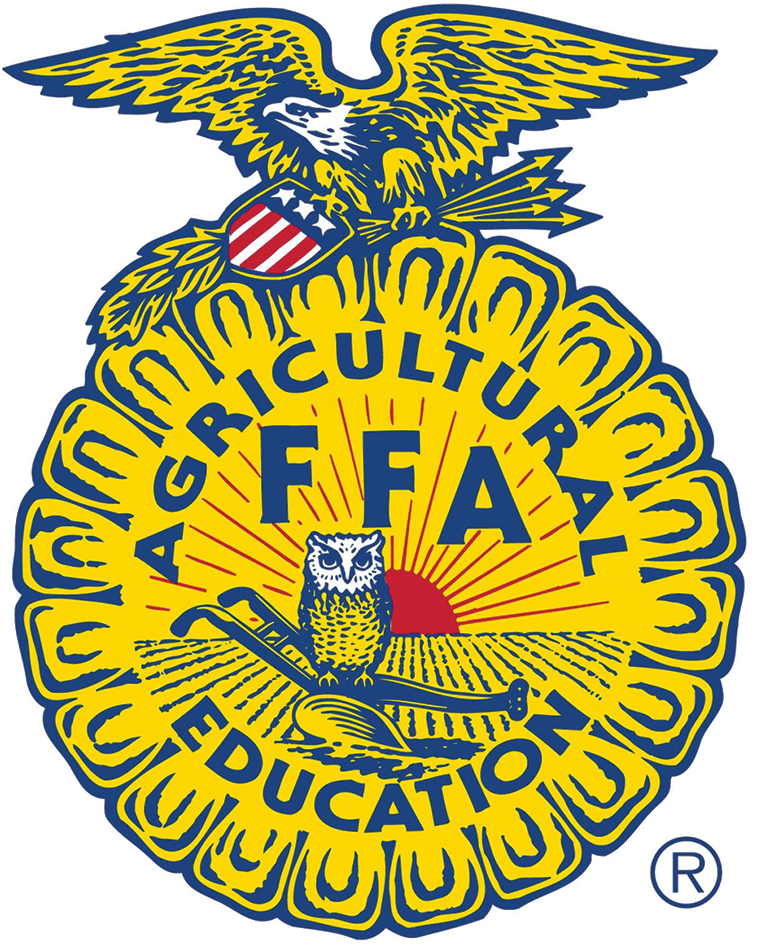FFA is a youth organization that promotes agricultural education in the United States. The organization helps students in grades 7 through 12 prepare for careers in farming, agricultural science, agribusiness (business involving agriculture), and other fields. It also trains them to become responsible citizens and leaders. FFA forms part of the agricultural education program in many U.S. public schools. The organization was established in 1928 as Future Farmers of America. In 1988, it changed its name to the National FFA Organization.

FFA has thousands of school chapters in the United States, Puerto Rico, and the Virgin Islands. A school must have a full-time agriculture teacher before it can form an FFA chapter. Only students who are studying agriculture may become members of the organization. Students may continue their membership for three years after they leave high school, or until they reach the age of 21, whichever is longer.
The FFA emblem features an owl, a plow, and a rising sun within the cross section of an ear of corn. An American eagle appears above the design. The owl represents wisdom and knowledge, and the plow stands for labor and tilling the soil. The rising sun symbolizes each new day of progress in agriculture. The corn stands for the agricultural interests of all FFA members. The eagle is a symbol of national freedom and the ability to explore new horizons.

FFA members wear distinctive blue corduroy jackets. The emblems and names on the jackets are embroidered in gold and blue, the FFA colors. FFA operates a merchandising unit that sells FFA clothing, jewelry, and other items. The organization also publishes New Horizons, a quarterly magazine for its members. In addition, FFA releases Making a Difference, a monthly e-mail newsletter for agriculture teachers.
The National FFA Organization has headquarters in Alexandria, Virginia. Its business center is in Indianapolis. The organization’s website at https://www.ffa.org presents information on its activities.
What FFA members do
Training.
Each FFA member carries out a project over several years called a supervised agricultural experience (SAE) program. Through SAE programs, members put into practice the knowledge gained in agriculture classes. Members usually begin with a small program, and then increase the scope of the program as they advance in their classroom work. An FFA adviser works with each student to supervise and help with the program. Members pursue programs in such areas as agricultural production, food science, forestry, agriculture sales and service, and horticulture (the science of growing flowers, fruits, vegetables, and plants).
FFA chapters often help members launch their programs. In some areas, an FFA chapter or a school may own a farm or greenhouse where members can work on their programs. The organization encourages members to expand their programs so that, by the time they complete high school, they will be prepared to enter the work force or to pursue further education.
FFA members investigate career opportunities in various fields related to agriculture. They study such subjects as farm economics, marketing, computer science, and biotechnology. In addition, they learn how to keep accurate financial records. With their teachers, members visit agribusinesses and agricultural experiment stations to observe the development of new agricultural methods. FFA also teaches members how to select, use, care for, and repair various types of equipment.
Through participation in chapter meetings, FFA members develop public speaking skills and learn to work with others for the benefit of the community. FFA officials recommend that chapters meet at least once a month.
Activities.
FFA members compete in local, state, and national contests and award programs. National contests are held in such fields as public speaking, agricultural mechanics, dairy cattle judging, livestock judging, poultry judging, dairy foods evaluation, meat evaluation, farm business management, forestry, and nursery skills and landscaping. Students also participate in competitions involving business and marketing skills.
Local FFA chapters sponsor recreational activities, organize educational tours, and conduct safety campaigns and home-improvement projects. They sometimes organize and manage community fairs. The chapters also hold annual parent-member banquets.
Degrees.
FFA awards its members various degrees for their achievements in agricultural projects, community service, cooperation, leadership, and scholarship. The Discovery degree may be granted to students based on knowledge gained in seventh- and eighth-grade agricultural education programs. The Greenhand degree is for FFA members in their first year of high school. To earn the Greenhand degree, members must demonstrate knowledge of FFA, its goals, and its history. After completing at least two semesters of agricultural course work, students become eligible to receive the Chapter FFA degree. Most FFA members receive the Chapter FFA degree. Once they earn the degree, they may wear a silver FFA pin.
The State FFA degree is much more difficult to attain. State FFA associations award this degree for outstanding achievement in agricultural career development, leadership, and scholarship. They present it at annual state conventions. A person who receives the degree must have worked at least 300 unpaid hours, or earned a specified amount of money and invested it productively. Members who have earned the State FFA degree wear a gold emblem pin.
The American FFA degree is the highest FFA degree. The National FFA Organization presents it each year to members nominated by the state associations. To qualify for the degree, a person must have earned a certain amount of money through SAE programs or earned a smaller amount and worked 2,250 hours outside class. In addition, the person must demonstrate outstanding leadership and community involvement. To encourage students to maintain their interest in agriculture, only FFA members who have been out of high school for at least one year may be nominated. Each person who earns the American FFA degree receives a gold key and partial travel expenses to the national convention.
FFA also presents honorary degrees to men and women who perform exceptional service to the organization. These individuals receive Honorary Chapter, State, or American FFA degrees and pins.
Awards
encourage FFA members to do better work in areas ranging from farm business management to computer technology. The National FFA Foundation, Inc., sponsors numerous proficiency awards for FFA members, including awards for agricultural mechanics, agricultural processing, agricultural sales and service, horticulture, natural resources, and production agriculture. The foundation presents four Star Farmer and four Star Agribusiness awards each year to outstanding candidates for the American FFA degree. Other national awards are made for group achievements in chapter activities and to winners of the national FFA public speaking contest.
State FFA associations present awards at state conventions. Local chapters award medals to outstanding members during parent-member banquets or at special school assemblies. Chapters offer awards in such fields as agricultural communications, food science and technology, horticulture, wildlife management, and safety.
Organization
FFA operates on local, state, and national levels. Student members belong to chapters organized at local schools. Agricultural instructors serve as chapter advisers. Chapters are organized under state associations. Each state association is headed by a state adviser and an executive secretary. The state associations are chartered by the National FFA Organization.
The National FFA Organization provides direction, materials, and support for the state associations. It also hosts a national convention every year. Delegates at the convention elect a president, a secretary, and four vice presidents. The four vice presidents represent the Central region, the Eastern region, the Southern region, and the Western region of FFA. The main governing body of the National FFA Organization is the board of directors. The board consists of the national FFA adviser, who serves as chairperson; state supervisors of agricultural education; and staff members of the U.S. Department of Education.
The National FFA Foundation, Inc., organized in 1944, collects donations from businesses to support FFA programs and activities. The National Alumni Association, formed in 1971, coordinates volunteer activities and promotes the development of FFA programs.
History
In 1917, Congress passed the Smith-Hughes Act, which gave the federal government the power to establish a national program of vocational education. It also permitted the government to pay half the cost of a vocational agriculture program in each state. The government now pays only about a sixth of the cost. The states and local communities pay the rest. A Federal Board for Vocational Education administered the Smith-Hughes Act at first. Later, the Department of Health, Education, and Welfare took over the management of the program. In 1980, the program was transferred to the newly created Department of Education.
In the early 1920’s, vocational agriculture students formed clubs in many communities throughout the country. In some states, the local clubs joined in statewide associations. One of these state associations—the Future Farmers of Virginia, founded in 1925—became the model for FFA. In November 1928, 33 representatives from 18 state associations met in Kansas City, Missouri. They adopted a constitution and founded Future Farmers of America, which would later become known as FFA. Congress granted the organization a federal charter in 1950.
In 1955, FFA began a program to promote international understanding. Since then, it has offered international exchange programs and helped promote agricultural education in a number of countries. In 1965, FFA joined with the New Farmers of America, an organization for African American agriculture students. In 1969, FFA delegates voted to allow girls to become FFA members. Formerly, only boys could join.
